# VT132

# Overview
I first tweeted about the VT132 in March 2019 I had put together a first prototype in time for mVCF - Melbourne (AUS)
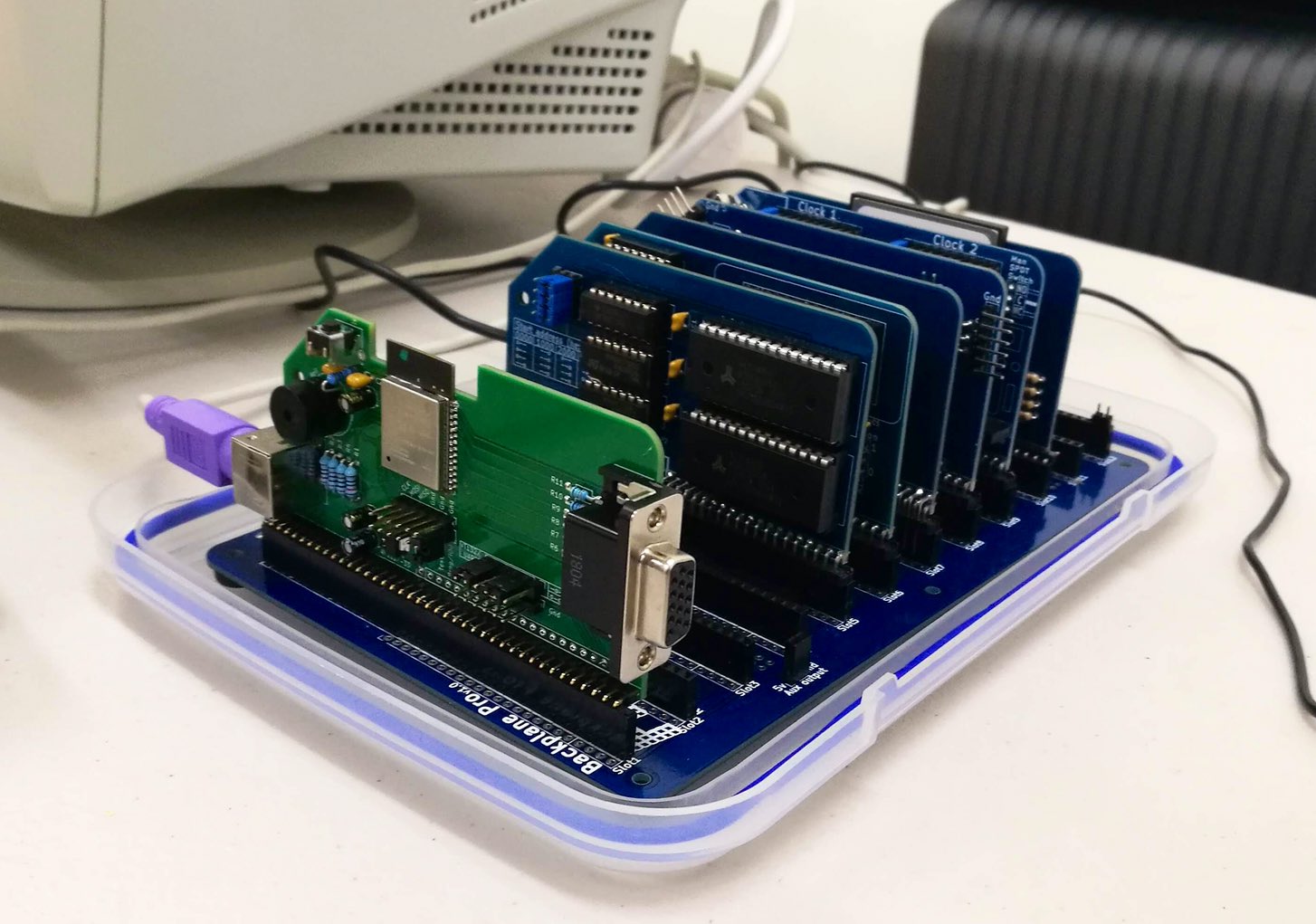
Back then it was simply the hardware implementation of the brilliant work done by Fabrizio Di Vittorio in creating the FabGL library for the ESP32. An ANSI/VT compatible, serially connected terminal with VGA output and a PS/2 keyboard.
But I wanted to extend his work and make a very authentic implementation of the DEC VT100 down to every reasonable detail.
Clearly from the prototype I'd already chosen the initial form-factor to be a "Designed for RC2014" expansion card for the RC2014 bus.
I then took a break from the VT132 while I worked to finish another little project - the IMSAI 8080 replica
In January 2020 I again tweeted about the VT132 because I'd started to play around with it once more.
I'd added most of the authentic VT100 features I could think of, and decided that since the ESP32 has lots of UARTS and WiFi, that I would include a Telnet over WiFi, 'AT' (Hayes) style modem on a second UART. I'd already developed the modem code for the IMSAI8080 replica, so it was easy to integrate it into the VT132.
This is where the fun/trouble began...
- FabGL is an Arduino library. Running FabGL @ 800x600 native resolution (800x300 scanline doubled) consumes a lot of the ESP32s internal memory.
- Turning on WiFi in the Arduino environment on an ESP32 also consumes a lot of the ESP32s internal memory.
- Moving to the ESP32-WROVER with 8Mb of SPRAM helps a little, but it's still the internal memory that is the limiting resource.
- The Arduino IDE for ESP32 doesn't let you control and fine-tune all the memory and network resource allocation like the ESP-IDF does.
- But Espressif thought of that...
- It is possible to run the Arduino library as a component in the ESP-IDF environment.
- I was easily able to make FabGL behave as an ESP-IDF component too.
By April 2020 I was able to start posting videos to YouTube showcasing the features of the VT132.
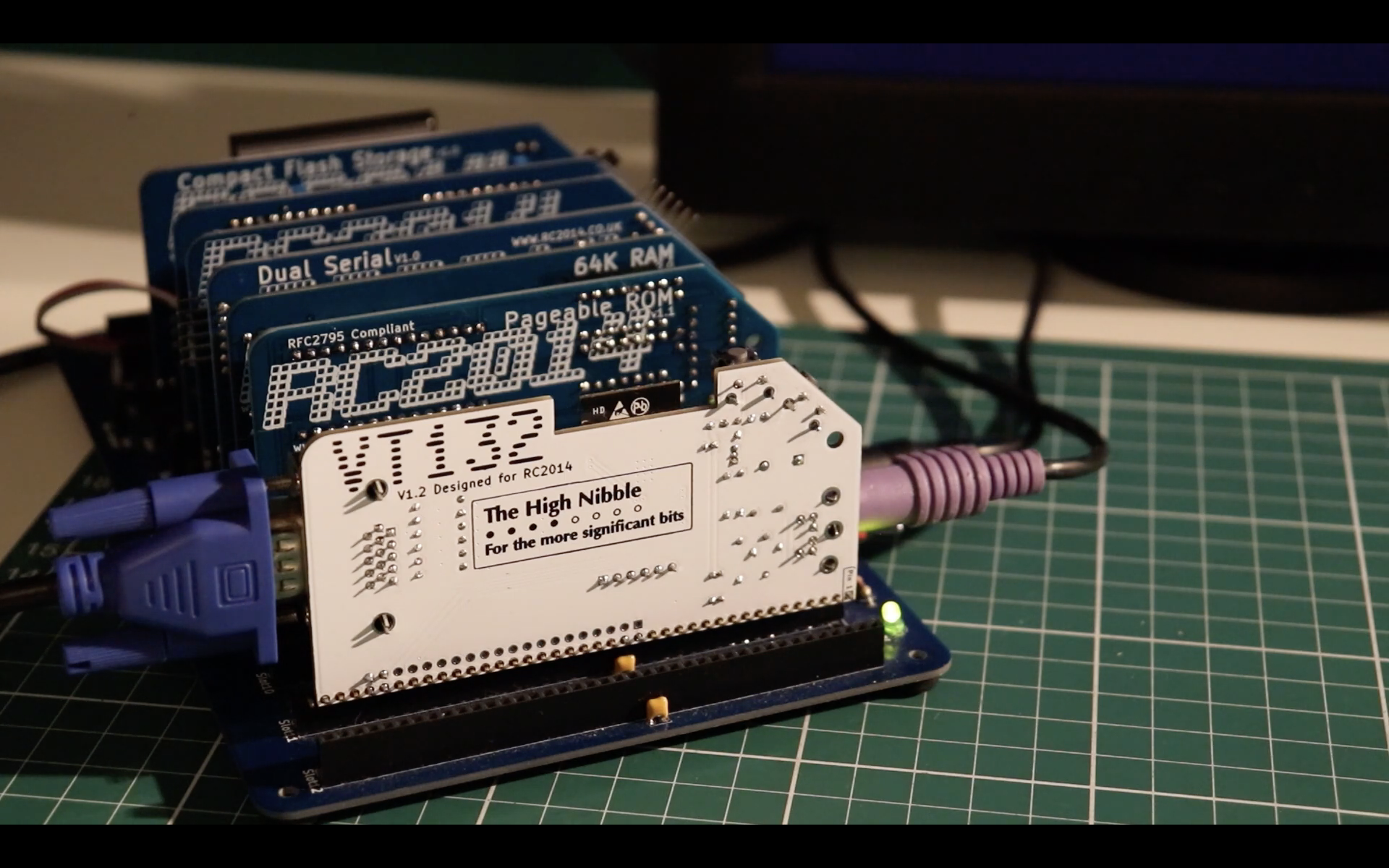
In June & July 2020 I conducted a closed Beta program with some fantastic people from the Retro-computer community. Their contribution to improving the VT132 and accelerating the development, ready for production has been invaluable.
# Editions
# VT132 Designed for RC2104 edition
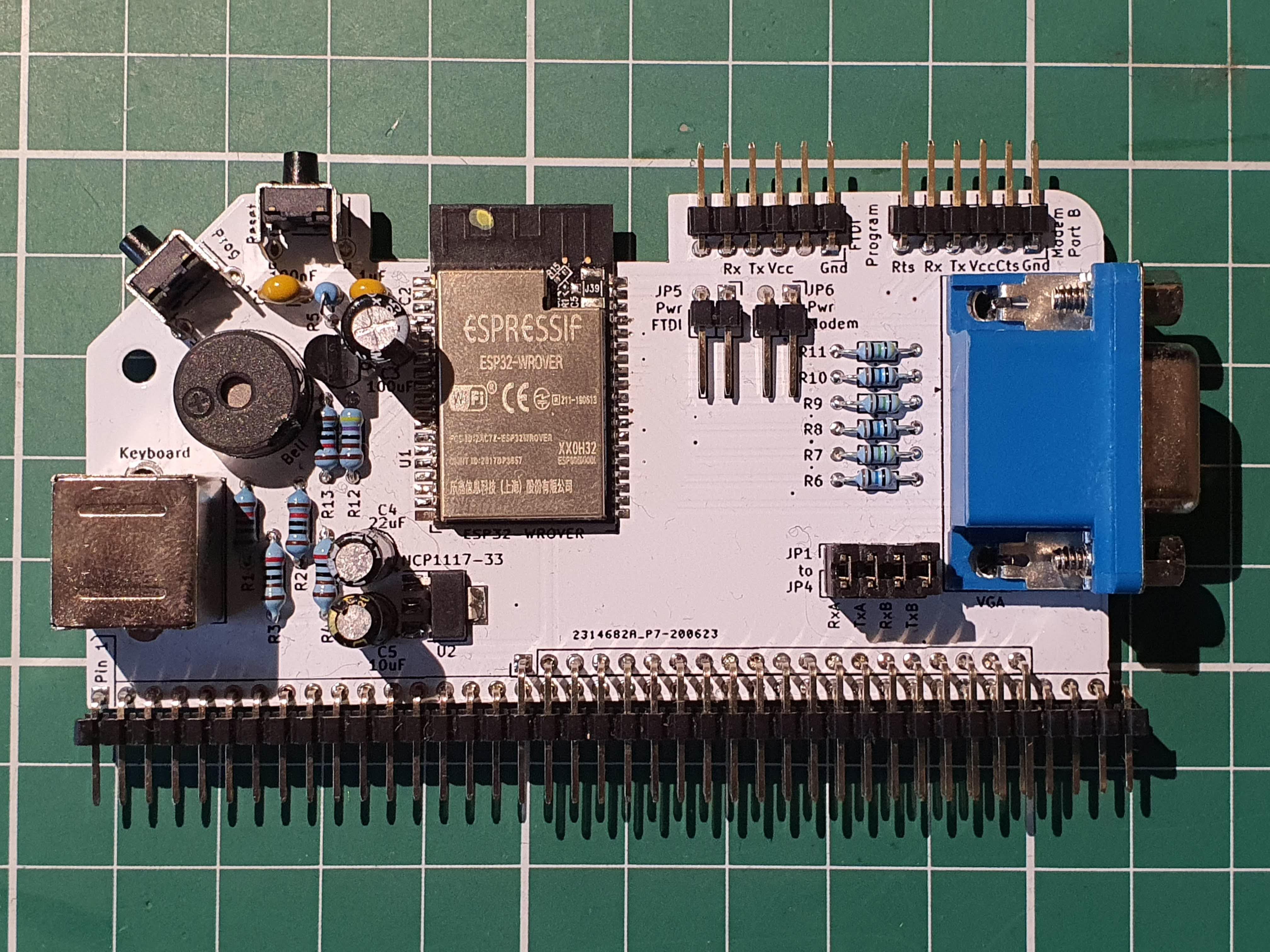
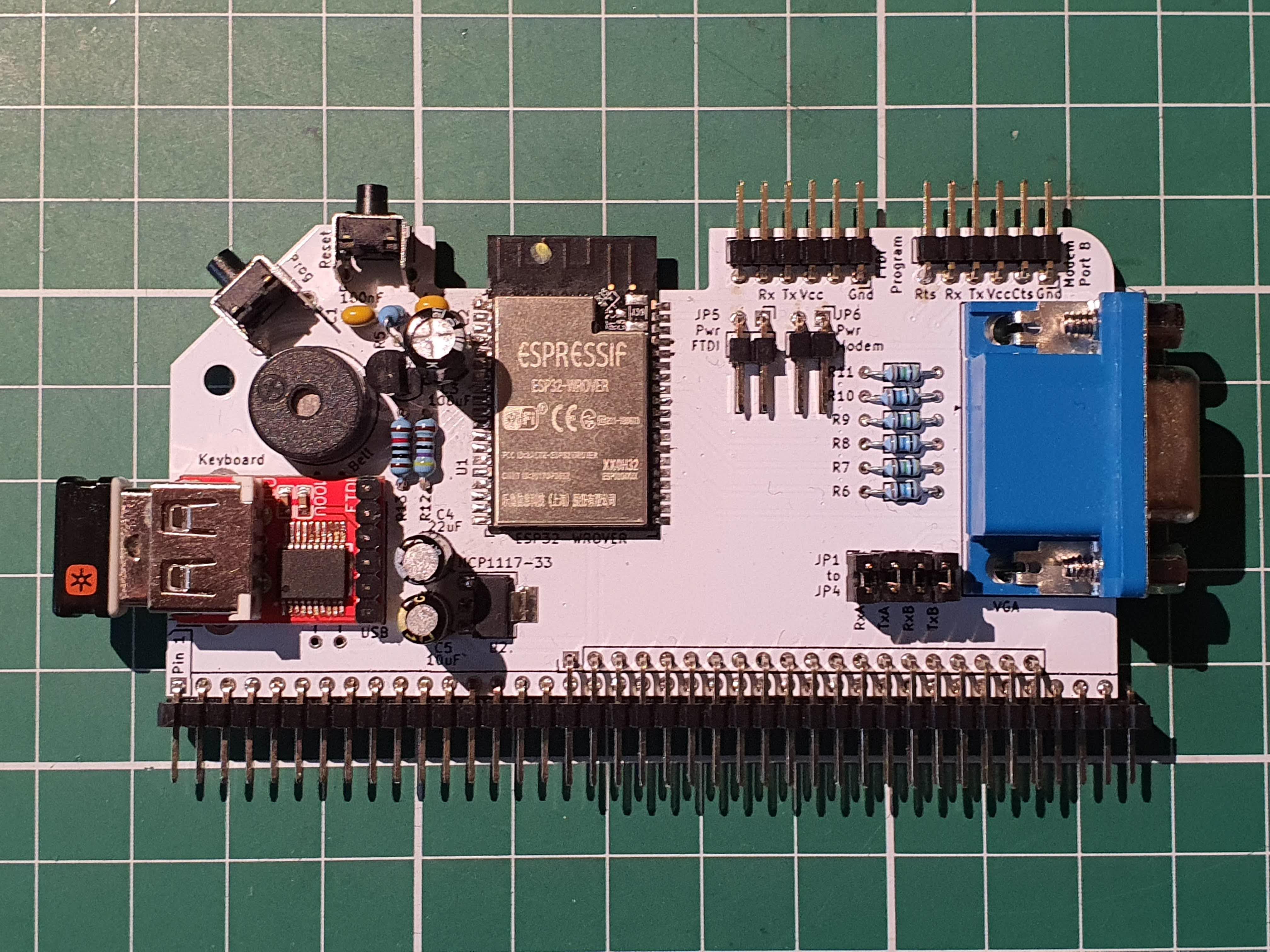
# (White PCB)
In July 2020 the VT132 Designed for RC2014 edition began shipping to the patiently waiting early-adopters.
# VT132 Stand Alone edition
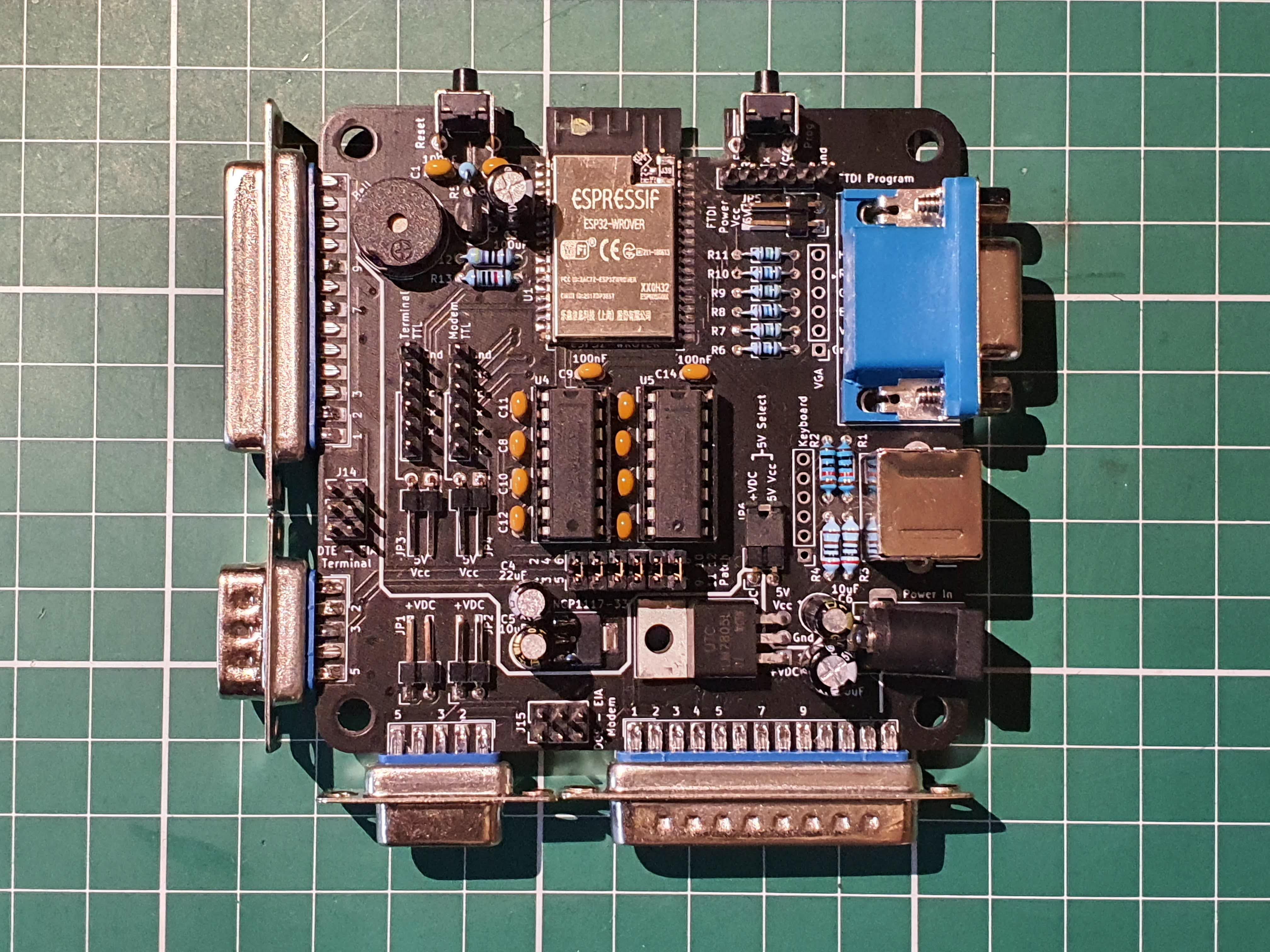
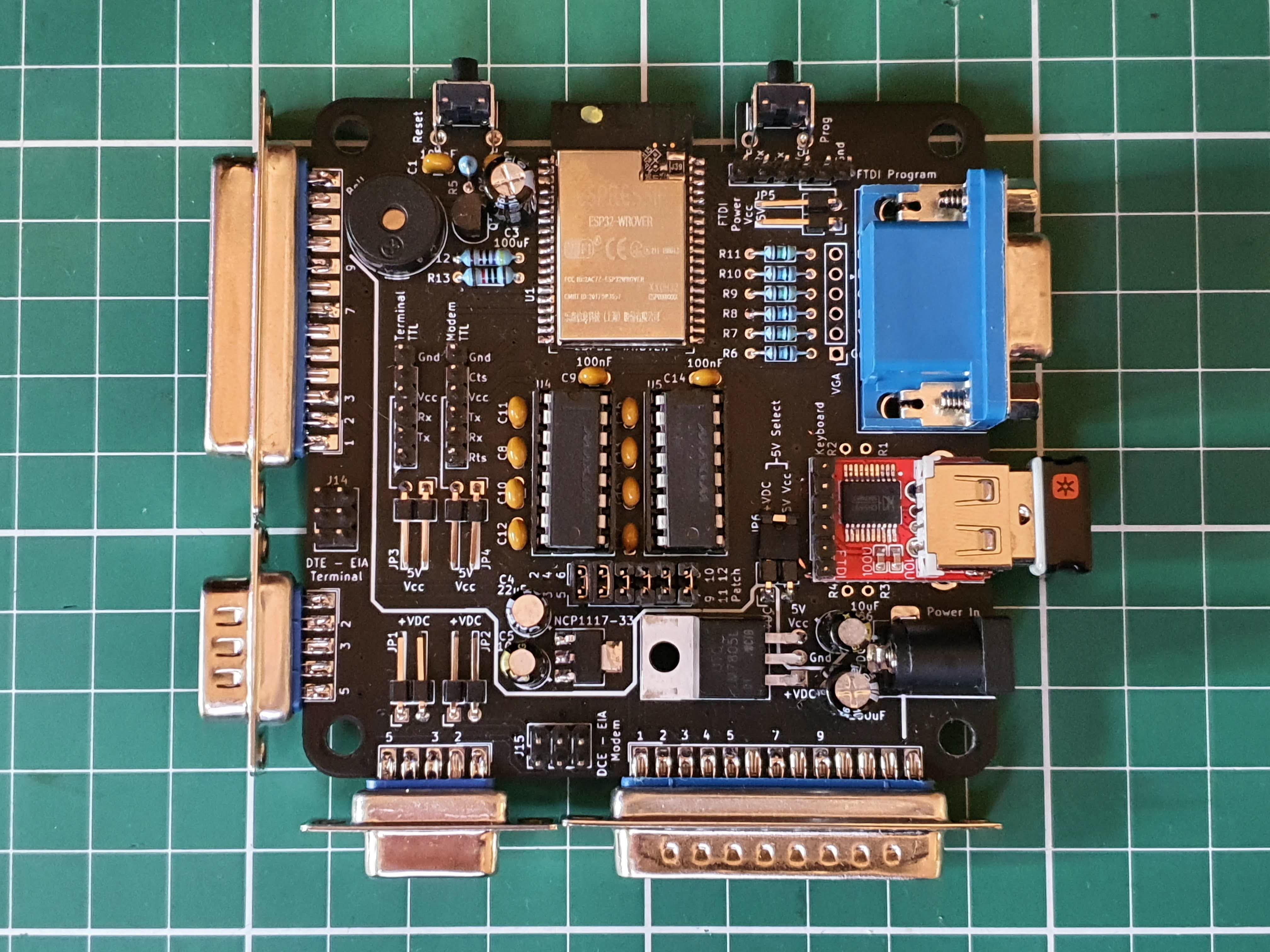
# (Black PCB)
Since its first release there has been regular feedback that a stand alone version of the VT132 would be warranted, to work with systems other than the RC2014.
In October 2020 the VT132 Stand Alone edition was released.
Note:
The two editions are functionally equivalent when it comes to the features of the VT100 terminal and the Telnet/WiFi 'AT' (Hayes) Modem
Where they differ is in respect to:
- powering the the VT132
- serial communications connectivity
- physical format and dimensions
See each section below for details.
# Features
# VT100 Terminal
- fully DEC VT100 Escape Code compatible
- extended escape code support from other DEC VTxxx models
- extended ANSI.SYS escape code support
- detailed in the Programmer Information manual
- 800x600 native resolution over VGA (DB15 connector) - actually 800x300 with scanline doubling
- 800x240 viewport in 24 line (native) mode
- 800x250 viewport in 25 line (enhanced) mode
- 800x300 viewport in 30 line (enhanced) mode (excludes the use of Wi-Fi because of memory constraints)
- 10x10 character cells in 80 column mode
- original DEC VT100 font (ASCII 7-bit) with pixel stretching as per the original VT100 hardware
- original DEC Special Graphics overlay font (inc. line drawing characters)
- original DEC VT220 Multinational Character Set (MCS) font (8-bit)
- DEC National Replacement Character Set (NRCS) support (7-bit) (from VT220)
- implemented for US/UK/French/German/Italian/Swedish, other countries to follow
- PC/VGA Code Page 437 font for ANSI.SYS compatibility
- supports DEC Special Graphics mapping to CP437
- supports NRCS mapping to CP437
- 6x10 character cells in 132 column mode
- modified DEC VT100 font (ASCII 7-bit)
- modified DEC Special Graphics overlay font (inc. line drawing characters)
- modified DEC VT220 Multinational Character Set (MCS) font (8-bit)
- DEC National Replacement Character Set (NRCS) support (from VT220) see above.
- no CP437 support in 132 column mode
- accurate Smooth Scrolling (requires XON/XOFF as per the original VT100 to avoid dropped characters)
- interlace/non-interlace mode (simulated: doubled scanlines are either hidden or drawn)
- implements all VT100 Advanced Video Option (AVO) features
- 132x24 (native), 132x25 & 132x30 (enhanced) character resolution
- additional character attributes - Bold, Blink, Underline, Reverse (and combinations)
- additional character ROM (NRCS and MCS fonts)
- PC 104/105 key keyboard, either one of (you must specify which you want when ordering):
- PS/2 keyboard (Mini-DIN 6, PS/2 connector)
- supports keyboard layouts for US/UK/French/German/Italian/Swedish, other countries to follow
- including dead-key support for composed characters with accent diacritics ` ´ ^ ¨ ~ (MCS 8-bit character set and CP437) - country specific
- supports keyboard layouts for US/UK/French/German/Italian/Swedish, other countries to follow
- USB-HID keyboard (standard USB Type-A socket)
- supports wired and wireless keyboards but not Bluetooth
- does not support use of a USB hub or keyboards with integrated hubs eg. the Raspberry Pi keyboard
- supports keyboard layouts for US/UK/French/German/Italian/Swedish, other countries to follow
- including dead-key support for composed characters with accent diacritics ` ´ ^ ¨ ~ (MCS 8-bit character set and CP437) - country specific
- PS/2 keyboard (Mini-DIN 6, PS/2 connector)
- implements user programmable answer back as per VT100
- implements a physical buzzer on the PCB for
- keyclick
- bell (^G)
- margin bell
- NVRAM error notification
- non-blocking (operates on a timer interrupt and does not block serial communications)
- implements 16 colour support
- complies with ANSI escape code selection
- use selectable default text and background colours via additional Set-up C screen
- user selectable for standard ANSI or VGA colour palette
- implements a scroll history buffer with a 100, 1000 or 5000 line capacity selectable
- activated by LeftAlt-Page Up key-press
- scroll history can be stepped through page-at-a-time (Page Up/Page Down keys)
- or line-by-line (Up/Down keys)
- and can be cleared on demand (Shift-C keys)
- implements a CRT Saver (screen saver) function with 10 second, 1, 5, 10, 20 or 30 minute selectable timeout
- full VT100 style Set-up screen implementation
- activated by Alt-SysReq key-press (usually Alt-PrintScreen)
- Set-up A (native as per VT100 with minor modifications)
- added 'T' command to restore default Tab-Stops (from VT102)
- Set-up B (native as per VT100 with minor modifications)
- added 'C' command to clear NVRAM
- 50/60Hz bit replaced by Backarrow Key Mode selection bit (DECBKM)
- added selection of how Bold font is represented (bright &/or double-thick)
- added selection of ANSI.SYS mode compatibility
- baud rates supported - 300, 1200, 2400, 4800, 9600, 19200, 38400, 57600, 115200
- fixed serial format 8N1, no current support for 7 bits, parity or 2 stop bits
- Set-up C (enhanced) enables:
- DEC/VT font or CP437 font selection
- 24 line (native) / 25 line / 30 line (enhanced) mode selection for ANSI compatibility
- default foreground text colour selection, 1 of 16 colours
- default background colour selection, 1 of 16 colours
- ANSI or VGA 16 colour palette selection
- Set-up D (enhanced) enables:
- 7-bit ASCII (native) / 8-bit MCS selection (enhanced)
- 7-bit NRCS country selection
- keyboard country/language selection
- personality selection
- personality (escape code and keyboard code translation) support for:
- ANSI/VT100, ADM-3A, ADM-31, Cromemco 3102, Hazeltine 1500, Osborne 1, Kaypro, VT52
- WordStar/VT100 - VT100 terminal with WordStar navigation keys for compatibility with many CP/M applications
- details on the Setup-D screen
- personality (escape code and keyboard code translation) support for:
- all Set-up screens include optional help by pressing 'F1' key (enhanced)
- Quick Menu system (modeled on the VT510 setup menus)
- activated by LeftAlt-Esc key-press
- provides quick access to:
- common actions, eg. clear screen, reset, reboot, clear NVR
- set/manage scroll history buffer and CRT saver functions
- terminal personality selection
- MCS/NRCS mode selection
- macros for ASCII modes including:
- Green/Amber/Blue/White screen emulation
- ANSI.SYS mode compatibility
- keyboard country/language selection
- modem locally connected mode (direct VT100 to modem connection)
- online/local mode selection
- Non-volatile Storage (NVRAM) support for all terminal settings
- save settings function - 'S' in Set-up screens, or from Quick Menu
- restore settings function - 'R' in Set-up screens, or from Quick Menu
- settings are restored on reset and power-up
- a 6-pin FTDI header with dedicated UART for firmware flashing and for debug log monitoring
- full details of configuring the terminal via the Set-up screens is covered in the VT100 Operator Information Manual
# VT132 Designed for RC2104 edition
- connects to the RC2014 over the Tx/Rx lines (Pins 35 & 36) of the RC2014 Bus
- takes power from the bus from Gnd/5V (Pins 17 & 18)
# VT132 Stand Alone edition
- many options for serial communications connectivity, including:
- 3.3V (5V tolerant) TTL level signaling with a 6-pin (straight, FTDI compatible) header
- RS-232/EIA level signaling via an optional MAX3232 level converter
- with a 6-pin (3x2) header
- with an optional DE-9 (Male) edge-mounted connector as DTE
- with an optional DB-25 (Female) edge-mounted connector as DTE
- many options for powering the VT132 Stand Alone edition exist
- 2.0mm DC Barrel Jack for +5VDC (regulated) or +8VDC to +12VDC unregulated
- optional onboard LM7805 to regulate +8VDC to +12VDC unregulated voltages
- +5VDC can be supplied to the VT132 via the 6-pin FTDI programming/debug header
- +5VDC can be supplied to the VT132 via the 6-pin TTL level Terminal header
- +5VDC can be supplied to the VT132 via the 6-pin TTL level Modem header
- +5VDC (regulated) or +8VDC to +12VDC unregulated voltage can be supplied to the VT132 on Pin-9 of any of the RS-232/EIA level connectors (6-pin (3x2) headers DTE/DCE , DE-9 M/F DTE or DB-25 F/M DCE)
- unregulated +8VDC to +12VDC voltages must be regulated by the optional onboard LM7805
- 2.0mm DC Barrel Jack for +5VDC (regulated) or +8VDC to +12VDC unregulated
# Telnet/WiFi 'AT' (Hayes) Modem
- implements a minimal set of 'AT' commands enabling it to behave as a serially connected modem
- supports storing all 'S' register settings in non-volatile storage (NVRAM)
- settings can be restored from NVRAM or restored to 'factory' defaults
- settings are restored from NVRAM on reset and power-up
- support 'DIAL' mode for outbound connections to hosts
- supports 'ANSWER' mode for inbound connections including simulated 'RING' cycle
- does not aim to reproduce every feature and command of any specific Hayes modem
- connects to a WiFi access point over 2.4 GHz (802.11 b/g/n) as a WiFi station (STA mode)
- cannot currently act as a WiFi access point (AP mode) - but this would be possible if it is a feature that people want
- supports Telnet and TCP socket protocols for connecting to hosts
- supports serial baud rates of 4800, 9600, 14400, 19200, 38400, 57600, 1152000 from the UART
- does not currently support 'autobaud'
- but is selected by the 'Prog' press button switch on the PCB
- the chosen speed is stored in NVRAM and persists through resets and power cycling
- does not currently support 'autobaud'
- supports CTS/RTS hardware flow-control
- a full list of the 'AT' command set implemented and details of all the 'S' registers and their use is covered in the 'AT' (Hayes) Serial Modem Operation Manual
# VT132 Designed for RC2104 edition
- connects to the RC2014 over the Tx2/Rx2 lines (Pins 35 & 36) of the RC2014 Enhanced Bus
- takes power from the bus from Gnd/5V (Pins 17 & 18)
- compatible with all the speeds of the RC2014 Dual Serial Module SIO/2 or similar
- CTS/RTS hardware flow-control over a 6-pin modified FTDI style modem header (not the RC2014 Enhanced Bus)
- making it compatible with the SC104 Z80 SIO/2 Module with CTS/RTS flow-control
# VT132 Stand Alone edition
- many options for serial communications connectivity, including:
- 3.3V (5V tolerant) TTL level signaling with a 6-pin (straight, modified FTDI) header
- RS-232/EIA level signaling via an optional MAX3232 level converter
- with a 6-pin (3x2) header
- with an optional DE-9 (Female) edge-mounted connector as DCE
- with an optional DB-25 (Male) edge-mounted connector as DCE
- many options for powering the VT132 Stand Alone edition exist see above
# Over-the-Air (OTA) Firmware Updates
- Firmware updates are hosted on GitHub
- The current production firmware can always be found at github.com/thehighnibble/vt132/releases/latest
- OTA Updates can be performed directly from the VT132 over Wi-Fi with only power, a VGA monitor and keyboard connected, no connected host (eg. RC2014 or PC) is required
The process for OTA Updates is covered in the OTA Firmware Update Guide
# Availability
# VT132 Designed for RC2104 edition
The VT132 Designed for RC2104 edition is currently available (since July 2020) and has a price of USD$50 for the the model with PS/2 keyboard support. In addition to this you must pay for shipping and any transaction fees. Payment is via PayPal.
# VT132 Stand Alone edition
The VT132 Stand Alone edition is now also available (since October 2020) and is also priced at USD$50 for the base model. In addition to this you must pay for shipping and any transaction fees. Payment is via PayPal.
- the base model has PS/2 keyboard support
- comes with the DC barrel jack and an LM7805 linear power regulator (and associated capacitors)
- includes headers for the TTL level Terminal and Modem connectors
- but does not come with the MAX3232 level converter ICs and sockets, supporting capacitors or RS-232 EIA DTE/DCE (DB25, DE9) connectors
- these parts are readily sourced from electronics suppliers such as Mouser, DigiKey & LCSC or other high street electronics stores eg. in Australia: Jaycar
# USB-HID keyboard support
The USB-HID keyboard support is priced as an option at an additional USD$5 owing to the extra parts (daughter PCB, CH559 microcontroller & USB Type-A socket).
# To Order
TIP
When ordering, please specify both:
- which edition you require: ie.
- Designed for RC2014, or
- Stand Alone
- which keyboard support you require: ie.
- PS/2 connector based keyboard, or
- USB Type-A, USB-HID based keyboard
I am accepting orders via email. If you send email to info@thehighnibble.com with your choice of configuration, shipping name & address, I will respond to you with a PayPal invoice with the total price including shipping and transaction fees.
WARNING
Please only pay against the PayPal invoice when I send it to you. Do not try to pay directly to me via PayPal as this will only delay your order.
# Specifications
# Dimensions (built)
# Designed for RC2104 edition
- Designed for RC2014
- Conforms to standard RC2014 card dimensions
# Stand Alone edition
# PCB dimensions
3 3/8" x 3 3/8"
85mm x 85mm
# VESA Mounting
M4 holes (1 in each corner of the PCB)
at 75mm centers
# Weight (built)
0.1 lbs
0.045 kg
# Power
# Designed for RC2104 edition
5VDC @ 500 mA (max., < 100mA typical) - Powered from RC2014 Bus or via FTDI or Modem connectors (jumper selectable).
# Stand Alone edition
TBA
# Dimensions (boxed/shipped)
7 1/2" x 5.5" x 2"
190mm x 140mm x 50mm
(width x height x depth)
# Weight (boxed/shipped)
less than 0.44 lbs
less than 0.2 kg